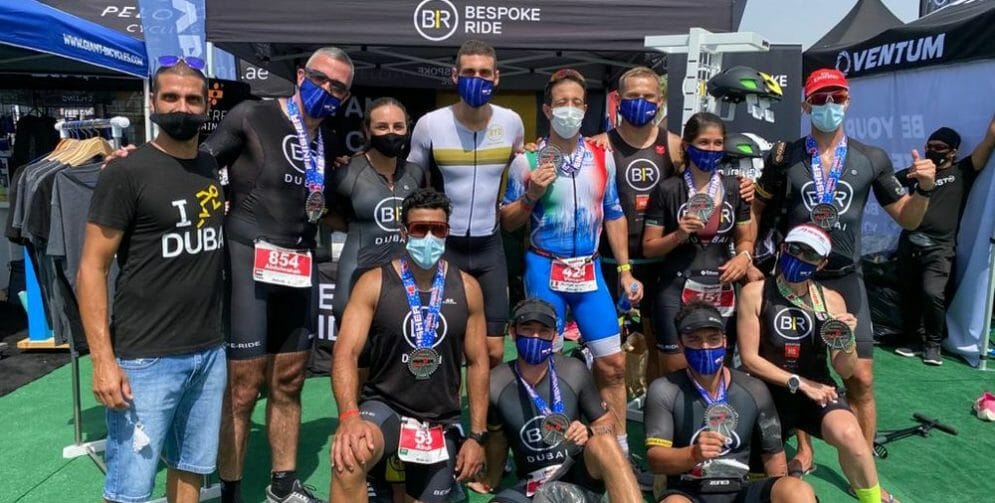
TRIATHLON: CONTROL THE CONTROLLABLE
Coaches and athletes’ pre-race rituals
Ironman 70.3 Dubai 2021 edition has flown by like a hurricane, collecting organizers, participants, and spectators’ energies and vibes and leaving Coaches and Athletes reflecting on what “kind” of training year we had.
Just crazy!

Triathlon teaches us to be comfortable in uncomfortable situations. With the uncertainty over the last year; our coaches + athletes adapted to the circumstances, controlling the controllable resulting in 42 BR athletes successfully completing IM DUBAI 70.3.
Training with no clear or near objective made us so aware of how much potential we had, but we just had to put this into practice.
And then came FEAR.
…The fear of not being ready, the fear to fail, the fear of pain, just because it has been a long time since the last “long one”…
So, there we were, preparing a strategy that would allow us to be the best performer we could be.
And voluntarily or involuntarily we started doing what Alex Bellini calls “ideomotor training”, visualization.
Visualization works for both Coaches and Athletes.
Coaches need to know everything about THAT race because their Athletes can ask literally anything. Athletes need to focus on the important things.
This is how it works.

Abdallah Alireza avoiding muscle cramps despite a significant amount of salt lost by planning + adjusting for the heat!
Step 1. The List
The Coach and the advanced Athlete write down a list of things that they can control during the race.
I can control the effort in the swim
I can control the cadence, the power on the bike
I can control how many times I sip from the bottle
I can control how many calories I can intake
I can control the pace on the run
And so on…
These are all the things that I don’t take any chances on changing a day prior the race or even worst on race day.
These are the things that I can control!
And I train, I train, I train with this list.
Why did I mention the advanced Athlete? This is an Athlete with body and race awareness who is capable to prepare his own list and have a discussion with his coach to prioritize.
The beginner Athlete is not going to prepare this list by himself but will study the one given by the Coach. There will not necessarily be a ceremony where the beginner will be handed that list. Day by day the beginner Athlete will learn, generally the hard way, the meaning of “controllable”.
Step 2. Mistakes
Few weeks in advance, if he did that race or had an Athlete who did it in the past, the Coach writes a list of mistakes, focusing on the way to fix them.
Then he tailors the training to exploit those mistakes and make sure that his Athlete understands the meaning of what has been done and achieved so far.
Working out in the areas where mistakes more likely will happen will make the Athlete more aware.
Joe Friel in “The Power Meter Handbook” says: “…pacing strategies need to be rehearsed in workouts as well. If you don’t practice these pacing skills in training, you are unlikely to do them on race day”.
Training day is a replica of racing day, not in terms of rehearsing the whole Full distance, but in terms of awareness of target zones, timely nutrition and why not, dealing with gastrointestinal issues the day of your long ride.
Step 3. Compare the List with the Mistakes
This comparison is going to look something like this:

It’s a simple process, which doesn’t require too much math, but requires visualization in order to become aware about the possibility to control what we objectively decided to be controllable and where the Coach has added Lessons learned and remedies to common mistakes.
What is the benefit of this process?
In a race there are already variables which can be outside our control like rain, wind, choppy sea, high temperature. Reducing the number of variables in the game is beneficial to reduce mental and physical stress before and during the race.
What about a flat tire?
Is it a controllable or an uncontrollable item?
If I had put it in my list then something, which at first, we would have said “it is uncontrollable” it becomes manageable and doesn’t scare us anymore, because the problem of the fear is that we don’t know how to deal with unknown adversities.

Forcing the system and training in a way that we made a plan to fix also the most extreme uncontrollable item, will let us prepare a very long list, which effectively will build a database of experience.
On race day, what will make the difference between Athletes is the ability to adapt to the curve balls that life will throw at us.
Better Athletes are those who adapt to situations faster because they have structured their mindset from day one of training to approach the race prepared.
Coach Tommaso
Sources
Alex Bellini “Oltre”
Joe Friel “The Power Meter Handbook”